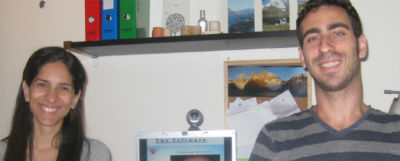A simple invention by two Israeli college students could provide a new weapon against the little-understood phenomenon of SIDS.

An invention of two Israeli college students could one day help new parents avoid the terrifying possibility of Sudden Infant Death Syndrome (SIDS). This little understood phenomenon otherwise known as “crib death” affects approximately two of every 1,000 babies worldwide, or 544,000 infants per year in the United States alone.
Algorithms programmed into BabyBeat’s software interpret images from a simple web camera in order to detect subtle changes in skin tone, indicating a slowed pulse. If it senses such a change, BabyBeat sounds an alarm that startles the infant back into a normal breathing pattern, and also alerts Mom and Dad. Parents don’t have to do anything but set the camera at bedtime.
BabyBeat was developed by electrical and computer engineering students Tomer Apel (27) and Anava Feinsilver (24) at Ben-Gurion University of the Negev as their senior project under Prof. Shlomi Arnon.
“It was our professor’s idea to measure pulse through skin color,” Apel tells ISRAEL21c. “We were interested in learning more about it. This took up our entire last year of our bachelor’s degree studies.”
Monitoring for high-risk babes?
The pair got a lot of attention for their project at an end-of-year display, and have been interviewed by local newspapers, radio and TV stations. But they’re not sure where it will go next. They hope the university can help them find a partner to further test and commercialize the system.
According to a university spokesman, “It’s too early to say what the next phase of development might be, if any.”
In the meantime, they are continuing their own informal testing of BabyBeat on their adult friends and on their sleeping baby nephews. Since it is completely non-invasive, it’s not hard to get cooperation from test subjects.
If it is indeed commercialized, BabyBeat has a variety of possible uses. For instance, hospitals and day-care centers could set it up on a computer near infant cribs to monitor the pulses of several babies at once. Results could be telecommunicated to physicians in cases of high-risk babies, in order to facilitate a faster response to any abnormality.
“Our goal was mainly to show that it can be done,” emphasizes Apel. “We don’t have all the time and resources to develop it further, but maybe someone else will do that.”













